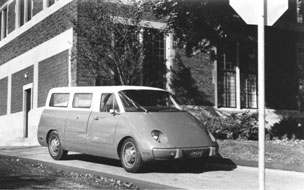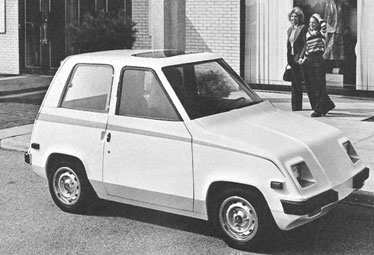March 5, 2010
FOR IMMEDIATE RELEASE
NEW YORK— Today copper is the one essential component of the electric vehicle (EV) that's not only here to stay - it's in even higher demand since the invention of the EV more than 100 years ago.
"From the beginning of the auto industry to the vehicles of today, copper is still the standard for electrical wiring," says Bob Weed, vice president of original equipment manufacturing for the Copper Development Association (CDA). "Today's vehicles are manufactured with more electronics equipment every year and copper is an important component."
In fact, the CDA played a role in the history of the modern electric vehicle, creating a prototype in the 1970s.
"We built prototypes of small electric passenger cars and built an electric van that was used by meter readers and repairmen in Birmingham, Mich.'s water department," Weed says. "It's gratifying to see consumers' renewed interest in EVs today."
A Vehicle for the Privileged at the Turn of the Century
Electric vehicles were popular among the upper class during the turn of the century because the wealthy lived in urban areas where they conducted business, says Bob Casey, curator of transportation for the Henry Ford Museum in Dearborn, Mich.
"Vehicle owners used their new electric-powered cars to travel within the cities where they lived," he says. "While there were other public transit options in the bigger cities, for many wealthy individuals owning a vehicle was a status symbol. There were great limitations on the distance these vehicles could travel without a recharge, so gasoline-powered cars soon became the preferred mode of transportation.
Electric vehicles are not new. In fact, they've been around for more than 100 years. France and England developed the first electric cars in the late 1800s. Americans developed their own version of the electric car by 1895. An early electric vehicle, the 1902 Wood's Phaeton, had a range of 18 miles with a top speed of 14 mph. Electric vehicles were not cheap. The 1922 Detroit Electric car on display at the North American Auto Shows this year would cost between $38,000-$40,000 in today's dollars, says Casey.
Wealthy women preferred the electric cars because they didn't want to crank a gasoline-powered vehicle or pull the gear shift. Neither was an easy task in those days. EVs didn't require gear shifting, they didn't smell of exhaust, and they were quieter than steam-powered and gasoline-fueled vehicles.
Electric cars were purchased into the 1920s, but they declined in popularity as a better system of roads resulted in Americans wanting to travel longer distances from city to city. The discovery of Texas crude oil reduced the price of gasoline, so the average person could afford it. And the mass production of internal combustion engine vehicles by Henry Ford for half the price of an electric car, ultimately led to their demise.
Copper Use in Electric Cars Today
Today's vehicles - both electric and gasoline powered - have a great deal more copper wiring than the early model electric vehicles like the 1922 Detroit Electric coupe. The new electric vehicles from Ford Motor Company, including Hybrid Electric Vehicles, Battery Electric vehicles (that are all electric), and Plug-in Hybrid Electric Vehicles (run on a battery plus gas engine) use more copper for all of their high and low voltage wiring and in the motor winding as well. While copper has a rich history in the automotive business, its properties continue to make it the electrical conductor of choice because of its consistency, durability, and the fact that it is a recyclable material that is good for our environment.
History of Electric Vehicles (EVs)
1832-1839
Scottish inventor Robert Anderson invents the first crude electric carriage powered by non-rechargeable primary cells.
1835
American Thomas Davenport is credited with building the first practical electric vehicle -- a small locomotive.
1859
French physicist Gaston Planté invents the rechargeable lead-acid storage battery. In 1881, his countryman Camille Faure will improve the storage battery's ability to supply current and invent the basic lead-acid battery used in automobiles.
1891
William Morrison of Des Moines, Iowa builds the first successful electric automobile in the United States.
1897
The first electric taxis hit the streets of New York City early in the year. The Pope Manufacturing Company of Connecticut becomes the first large-scale American electric automobile manufacturer.
1899
Believing that electricity will run autos in the future, Thomas Alva Edison begins his mission to create a long-lasting, powerful battery for commercial automobiles. Though his research yields some improvements to the alkaline battery, he ultimately abandons his quest a decade later.
1900
The electric automobile is in its heyday. Of the 4,192 cars produced in the United States 28 percent are powered by electricity, and electric autos represent about one-third of all cars found on the roads of New York City, Boston, and Chicago.
1908
Henry Ford introduces the mass-produced and gasoline-powered Model T, which will have a profound effect on the U.S. automobile market.
1912
Charles Kettering invents the first practical electric automobile starter. Kettering's invention makes gasoline-powered autos more alluring to consumers by eliminating the unwieldy hand crank starter and ultimately helps pave the way for the electric car's demise.
1920
During the 1920s the electric car ceases to be a viable commercial product. The electric car's downfall is attributable to a number of factors, including the desire for longer distance vehicles, their lack of horsepower, and the ready availability of gasoline.
1966
Congress introduces the earliest bills recommending use of electric vehicles as a means of reducing air pollution. A Gallup poll indicates that 33 million Americans are interested in electric vehicles.
1970s
Concerns about the soaring price of oil -- peaking with the Arab Oil Embargo of 1973 -- and a growing environmental movement result in renewed interests in electric cars from both consumers and producers.
1972
Victor Wouk, the "Godfather of the Hybrid," builds the first full-powered, full-size hybrid vehicle out of a 1972 Buick Skylark provided by General Motors (G.M.) for the 1970 Federal Clean Car Incentive Program.
1973-1979
The Copper Development Association (CDA) builds and tests three electric vehicles to demonstrate the viability of copper with the new technology. The vehicles included the Copper Electric Town Car, the Copper Electric Runabout and the Copper Utility Van. The van was used successfully by the city of Birmingham, Mich. for six years before it was removed from service to evaluate the durability of its batteries and electronics.
 Copper Utility Van created by the CDA
Copper Utility Van created by the CDA The CDA's Copper Electric Runabout
The CDA's Copper Electric Runabout1990-Present
Automakers manufacture a variety of hybrid and electric cars. Despite promising signs, the electric car will need to navigate a bumpy road before it can become a viable option for many drivers. Challenges to mass adoption include high sticker prices, limited battery life and travel range, and building charging stations and other infrastructure to support electric vehicles.
Sources:
- Hybridcars.com: History
- Electric Auto Association: Electric Vehicle History
- IEEE Power Engineering Society: "Electric Vehicles In The Early Years Of The Automobile" by Carl Sulzberger
- About.com: The History of Electric Vehicles
- Econogics: EV History, Smithsonian Institution: Edison After Forty
- Copper Development Association
###
